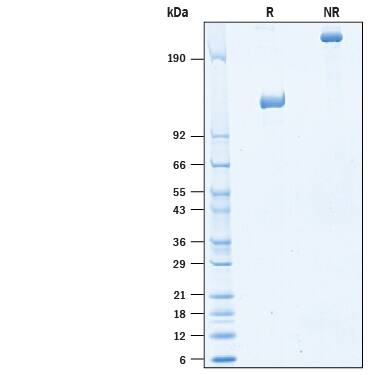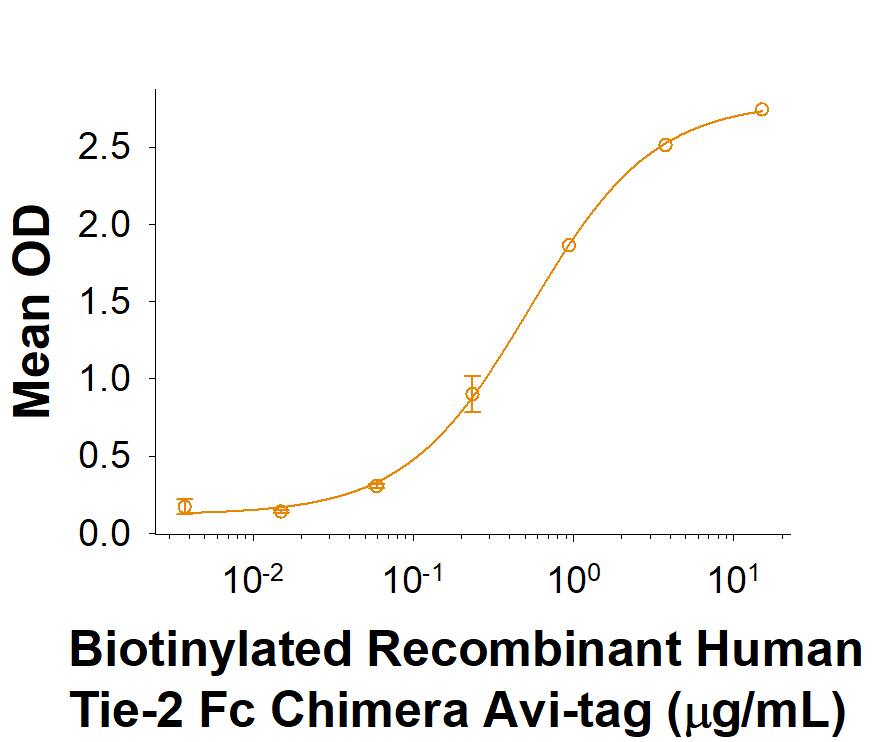Recombinant Human Tie-2 Fc Chimera Avi-tag Protein, CF
R&D Systems, part of Bio-Techne | Catalog # AVI10727

Key Product Details
Source
Accession #
Structure / Form
Conjugate
Applications
Product Specifications
Source
| Human Tie-2 (Ala23-Lys745) Accession # AAA61139.1 |
DIEGRMD | Human IgG1 (Pro100-Lys330) |
Avi-tag |
| N-terminus | C-terminus | ||
Purity
Endotoxin Level
N-terminal Sequence Analysis
Predicted Molecular Mass
SDS-PAGE
Activity
When Recombinant Human Angiopoietin-2 (Catalog # 623-AN/CF) is immobilized at 0.25 µg/mL (100 µL/well), Biotinylated Recombinant Human Tie-2 Fc Chimera Avi-tag binds with an ED50 of 0.3-1.8 ug/mL.
Scientific Data Images for Recombinant Human Tie-2 Fc Chimera Avi-tag Protein, CF
Biotinylated Recombinant Human Tie-2 Fc Chimera Avi-tag Protein Binding Activity.
When Recombinant Human Angiopoietin-2 (623-AN/CF) is immobilized at 0.25 µg/mL (100 µL/well), Biotinylated Recombinant Human Tie-2 Fc Chimera Avi-tag (Catalog # AVI10727) binds with an ED50 of 0.3-1.8 μg/mL.Biotinylated Recombinant Human Tie-2 Fc Chimera Avi-tag Protein SDS-PAGE.
2 μg/lane of Biotinylated Recombinant Human Tie-2 Fc Chimera Avi-tag (Catalog # AVI10727) was resolved with SDS-PAGE under reducing (R) and non-reducing (NR) conditions and visualized by Coomassie® Blue staining, showing bands at 115-132 kDa and 220-260 kDa, respectively.Formulation, Preparation and Storage
AVI10727
| Formulation | Lyophilized from a 0.2 μm filtered solution in PBS with Trehalose. |
| Reconstitution | Reconstitute at 500 μg/mL in PBS. |
| Shipping | The product is shipped at ambient temperature. Upon receipt, store it immediately at the temperature recommended below. |
| Stability & Storage | Use a manual defrost freezer and avoid repeated freeze-thaw cycles.
|
Background: Tie-2
Tie-1/Tie (tyrosine kinase with Ig and EGF homology domains 1) and Tie-2/Tek comprise a receptor tyrosine kinase (RTK) subfamily with unique structural characteristics: two immunoglobulin-like domains flanking three epidermal growth factor (EGF)-like domains and followed by three fibronectin type III-like repeats in the extracellular region and a split tyrosine kinase domain in the cytoplasmic region. These receptors are expressed primarily on endothelial and hematopoietic progenitor cells and play critical roles in angiogenesis, vasculogenesis and hematopoiesis.
Human Tie-2 cDNA encodes a 1124 amino acid (aa) residue precursor protein with an 18 residue putative signal peptide, a 727 residue extracellular domain and a 354 residue cytoplasmic domain. Two ligands, angiopoietin-1 (Ang-1) and angiopoietin-2 (Ang-2), which bind Tie-2 with high-affinity have been identified. Ang-2 has been reported to act as an antagonist for Ang-1. Mice engineered to overexpress Ang-2 or to lack Ang-1 or Tie-2 display similar angiogenesis defects. Our Avi-tag Biotinylated Human Tie-2 features biotinylation at a single site contained within the Avi-tag, a unique 15 amino acid peptide. Protein orientation will be uniform when bound to streptavidin-coated surface due to the precise control of biotinylation and the rest of the protein is uncharged so there is no interference in the protein's bioactivity.
References
- Partanen, J. and D.J. Dumont (1999) Curr. Top. Microbiol. Immunol. 237:159.
- Takakura, N. et al. (1998) Immunity 9:677.
- Procopio, W. et al. (1999) J. Biol. Chem. 274:30196.
Long Name
Alternate Names
Entrez Gene IDs
Gene Symbol
UniProt
Additional Tie-2 Products
Product Documents for Recombinant Human Tie-2 Fc Chimera Avi-tag Protein, CF
Product Specific Notices for Recombinant Human Tie-2 Fc Chimera Avi-tag Protein, CF
For research use only

